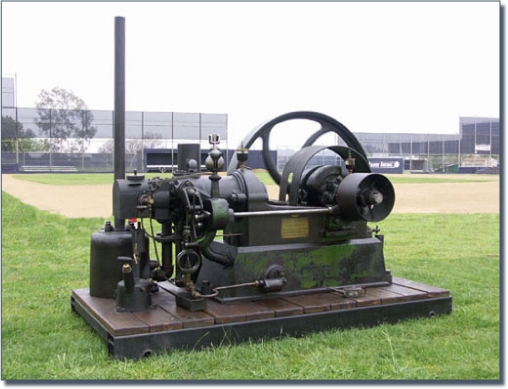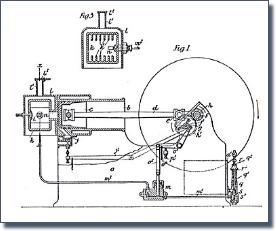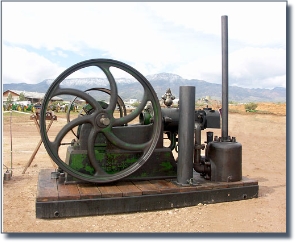 |
 |
|
 |
 |
|
 |
|
 |
 |
|
 |
|
|
|
 |
|
|
Shown here is a type 1905 Richard Hornsby oil engine. This particular unit is rated at six horsepower. It left the Hornsby factory on December 7, 1910. It was sold to V. A. Lawson, Esq., of Circle Street, Cirencester, agent for the Rural District Council of Lechlade. The engine was used for pumping purposes.
The use of oil as a means of producing motive power was not a new idea at the time the Hornsby-Akroyd engine was developed. The concept was documented as early as 1791 by Street, but it was not until 1870 that Julis Hock built a workable petroleum engine. Hock's was a non-compression engine, similar to that of Lenoir. Others made refinements to the oil engine; Priestman, Brayton and Capitaine are some of the more notable. However, it was Herbert Akroyd Stuart's design that was the most successful.
|
|
|
|
Stuart's design was simple, reliable and economical. The engine utilized a combustion chamber, or "vaporizer," separated from the main part of the cylinder by a narrow passageway. Vaporization of the fuel is accomplished by the injection of liquid fuel onto the hot inner surface of the vaporizer. The surface is sufficiently hot to cause ignition of the mixture of fuel and air when compression is completed. The heat of combustion is enough to maintain the high temperature of the vaporizer surface.
To start, the vaporizer is heated by a separate lamp. After five to ten minutes, oil is injected onto the hot vaporizer surface, where it quickly gassifies, and the engine is rotated by hand in the standard fashion.
The Stuart engine is of four cycle design. During the intake stroke, fresh air is inducted into the cylinder through a mechanically operated intake valve. Simultaneously, oil is injected into the vaporizer. The vapor of the oil is almost entirely confined to the vaporizer chamber. This cloud of hot oil vapor is too rich to support combustion. On the compression stroke of the piston, the fresh air is forced through the narrow neck and into the vaporizer. Just as compression is completed, the mixture is just right to support combustion and ignition occurs.
|
|
|
 |
|
|
|
|
Richard Hornsby & Sons was a large manufacturer of steam engines and agricultural equipment in 1891 when they entered into an exclusive contract with Herbert Akroyd Stuart to manufacture what would be known as the Hornsby-Akroyd oil engine. The engine was hugely successful. During the period from 1891 through 1905, a total of 32,417 engines were produced.
After Akroyd Stuart's patent elapsed, Hornsby made minor improvements to the design and the result is known as the type 1905 Hornsby oil engine.
|
|
|
 |
|
|
|
|
 |
|
|
|
- In 1898, a Hornsby designed engine was used to provide electrical power for the Statue of Liberty.
- In 1896, Hornsby built the world's first tractor and locomotive powered by oil engines.
- Manufacturers in Sweden and Denmark built thousands of engines using the Hornsby design to power fishing boats.
- Marconi used a Hornsby engine for power in his early wireless telegraphy experiments.
- Among the famous people who have used Hornsby engines are Rudyard Kipling, the Duke of Roxburghe, Viscount Curzon, Lord Rothschild and the Czar of Russia.
- A Hornsby engine was used to light the Taj Mahal and the tunnels in the Rock of Gibralar.
- Hornsby engines were used in the Arctic Circle, Malta, Egypt, Sudan, Palestine, Jerusalem, Jaffa, India, South and Central Africa and South America.
- Hornsby developed and patented the first fully tracked crawler. They sold the patent to Holt, in California, which eventually became "Caterpillar.
|
|
|
|
|
| |
 |
 |
 |
 |
 |
 |
 |
 |
 |
 |
 |
 |
 |
 |
 |
 |
 |
 |
 |
 |
 |